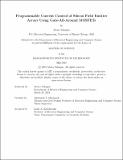Programmable Current Control of Silicon Field Emitter Arrays Using Gate-All-Around MOSFETs
Author(s)
Sahagun, Alvaro
DownloadThesis PDF (12.58Mb)
Advisor
Akinwande, Akintunde I.
Terms of use
Metadata
Show full item recordAbstract
Silicon field emitter array (FEA) technology has great potential for applications such as electron microscopy, vacuum electronics, and X-ray sources. However, some challenges such as emitter tip burnout and spatial and temporal non-uniformity of emission current impede the adoption of FEAs in these applications. The current approach to address these challenges involves integrating a resistor, nanowire (NW) current limiter, or metal-oxide-semiconductor field-effect transistor (MOSFET) in series with the emitter tips to regulate current flow. The NW current limiter is preferred for its compact integration, which enables high emitter density in FEAs. However, it restricts the FEA versatility by constraining the emission current to a fixed maximum value. Whereas, MOSFETs provide the ability for programmable control over emission current, enabling FEA versatility. Integrating planar MOSFETs into FEAs demands significant space, leading to a notable reduction in emitter density and FEA compactness. This thesis investigates the integration of vertical gate-all-around (GAA) MOSFETs with individual emitter tips as a solution to enable programmable emission control while preserving the compactness, high emitter density, and versatility of FEAs. To achieve this, SILVACO, a device simulation platform, was used to model the GAA MOSFET, field emitter, and combined GAA MOSFET-FEA devices. The simulation results provide insight into each device's current-voltage (I-V) characteristics, identifying performance-limiting challenges such as breakdown, kinks in the I-V characteristics, and quasi-saturation of the current. Various solutions to these challenges are explored through simulations, and the resulting models show the feasibility of using a GAA MOSFET as a voltage-controlled current source in series with individual field emitter tips to program emission current.
Date issued
2024-05Department
Massachusetts Institute of Technology. Department of Electrical Engineering and Computer SciencePublisher
Massachusetts Institute of Technology